The best dog breeds for over 50s
Last reviewed 20th August 2024
12 min read
The best dogs for over 50s tend to be those low-maintenance pooches – the ones that are just as happy to snuggle on the sofa as they are to stroll through the park. But whichever breed you choose, dogs make a wonderful companion, especially for your golden years.
If you’re thinking about getting your own four-legged friend, this article may help you make a decision. As well as providing unmatched friendship throughout your retirement, dogs have been shown to boost your physical and mental health. They’re also great company during any retirement hobbies.
And it’s not just you who’ll enjoy the benefits – your pooch will love it too. Rather than rushing off to work, over 50s and retirees can have a more flexible schedule, which means they can spend more time on walks, cuddles and belly scratches (all the important stuff).
Although small dogs can be a great choice, the best dog breeds for over 50s and retirees actually come in all shapes and sizes. To make things easy for you, we’ve put together this handy little guide to help you find your perfect pooch.
How to choose the best dog breed for your home
Although it’s important to think about which breed of dog is right for you, it’s also worth thinking about which breed will be right for your home. Here are a few things to consider when you’re on the lookout for a new furry friend.
Size
At any age, size is one of the most important considerations when you’re getting a dog, but it’s especially important for over 50s and retirees. For example, if you’re living in a small property, such as an apartment, bungalow or care facility, a small dog might be the best choice for you.
Because of their nifty size, small dogs are easier to keep under control, and won’t have much power if they pull on their lead. Their size also means they’re easier to keep clean, and best of all, they fit perfectly on your lap, so they’re great for cuddles!
But it’s also important to remember that some small dog breeds have lots of nervous energy. These little pups sometimes try to make up for their small size with lots of barking. On the other hand, some large and medium-sized dogs can be incredibly gentle and well-mannered. So, if you’ve got the space, the right dog for you might actually be a larger breed.
Age
Another important thing to think about when you’re getting a dog is age, especially when it comes to deciding between a puppy and an adult dog. There are a few reasons why adult dogs tend to be the best dogs for over 50s.
For one, they’re usually already house-trained, which means you don’t have to worry about getting on the floor to clean up lots of messes. Secondly, they’re also usually well-socialised with people and tend not to be as hyperactive as younger dogs.
When you’re looking for an adult dog, adoption can be a great way to go. Puppies are always the most sought-after dogs when it comes to adopting, so choosing an adult dog is a great way to give that dog a second chance.
It’s also worth considering adopting an older or ‘senior’ dog, which is usually considered any dog over the age of six or seven. Because of their age, senior dogs sometimes struggle to find a home, but they can make extremely loving, gentle pets. There’s also less chance of you having to worry about finding care for them after you’re gone. Although it’s not nice to think about, it’s always important to consider the chances of your new dog outliving you.
Energy and disposition
Finding a dog with the right energy and disposition for your lifestyle is incredibly important when looking for a companion in your later years. For example, if you’ve got reduced mobility or a fairly sedentary lifestyle, you won’t want a dog that needs miles and miles of walking every day.
If you’re fairly active, you might be able to handle a dog that needs lots of walks and playtime, but it’s also worth thinking about the way your activity levels might decrease as you get older. On the other hand, some very small dogs can get all the exercise they need just by running around inside your home.
Grooming
This one’s easy to forget about, so we’re here to remind you! Some dog breeds need to be bathed, trimmed and clipped regularly to keep them comfortable and happy, while others just need a quick brush and the odd bath. Make sure you choose a dog whose needs you can manage. Whether that’s by yourself, or with the help of a family member or a professional groomer.
The top 10 dogs for over 50s and retirees
Now you’ve got all the factors you need to consider when you’re choosing a dog, let’s have a look at some specific dog breeds. Not all dogs will be well suited to over 50s and retirees – that’s why we’ve rounded up the 10 best dog breeds for companionship in later life.
Please note, these aren’t in any particular order – it’s all finding which dog is right for you!
1. West Highland white terrier
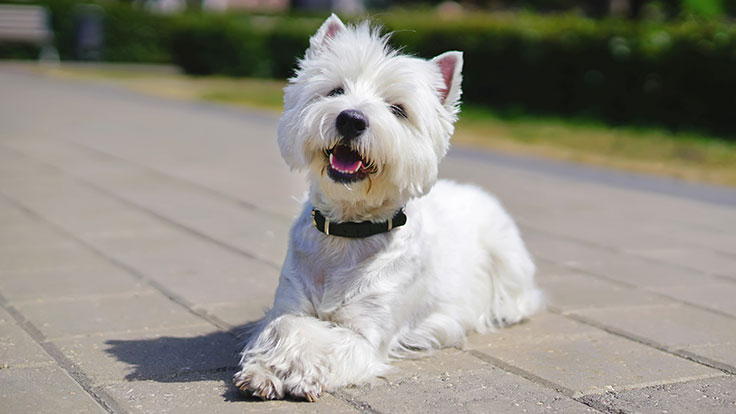
This is a dog that will instantly want to be your friend. Commonly known as a ‘westie’, West Highland white terriers make a wonderful companion for over 50s. Not only are they small in size, but they’re also incredibly happy and friendly. Because of their cheerful disposition, they’re great with strangers and kids, and they get on happily with other dogs. They’ve got a double coat, so they’ll need a little bit of grooming, but they’re not too tricky to keep tidy.
One of the good things about westies is that they don’t suffer from ‘small dog syndrome’, so they’re not overly barky, pushy or temperamental. But they do have fairly high energy levels. They love walks and lots of playtime, so make sure you’re ready to give them the attention they need.
Breed type: Terrier
Coat and colour: Medium double coat (white)
Size: 10-11 inches tall at the shoulder (weight: 13-22 pounds)
Life expectancy: 12-16 years
2. Poodle
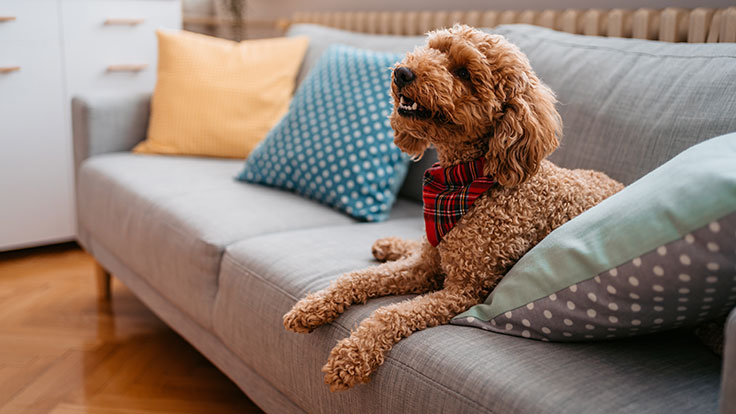
Behind their fancy hairdos, poodles are one of the smartest dog breeds in the world – which means they’re really easy to train. But this also means they need loads of mental and physical stimulation, so get ready for lots of walking, playtime and training games.
Now, let’s get back to that fancy hairdo: it needs a lot of maintenance! Poodles generally need a trip to the groomers every three to six weeks, unless you’re ready to learn to do it yourself. The other good thing about poodles is that they come in three different sizes (Toy, Miniature and Standard), so it’s easy to find your perfect fit.
As well as being super smart, poodles are also incredibly loving – they’re great with both kids and strangers. They’d prefer to hang out with you all day, so don’t like to be left alone for long.
Breed type: Companion
Coat and colour: Long curly coat, non-shedding (can be found in a variety of colours, including black, grey, silver, brown and apricot)
Size: 10-22 inches tall at the shoulder (weight: 6-70 pounds)
Life expectancy: 12-15 years
3. Shih tzu

Despite the fact that their name literally translates as ‘little lion’, these loveable little pooches are incredibly friendly and will love to snuggle up on your lap. They’re also brilliant with children, strangers and other dogs, so they make a great family dog (they won’t mind being handled when your grandchildren stop by).
These confident little dogs enjoy short bursts of playtime, but generally have fairly low energy levels, making them the perfect breed for less active people. One thing to be aware of, though, is that beautiful fur – it takes a lot of grooming! If you keep your shih tzu’s hair long, it needs brushing once a day to keep the tangles out, and they’ll need a bath about once a week. Keeping their coat short can help minimise those daily brushes, but they’ll need to go to the groomers at least every six weeks to keep up their trim.
Breed type: Companion
Coat and colour: Long double coat (can come in a variety of colours, including black, black and white, red and white, and grey and white)
Size: 9-10 inches tall at the shoulder (weight: 9-16 pounds)
Life expectancy: 10-16 years
4. Greyhound
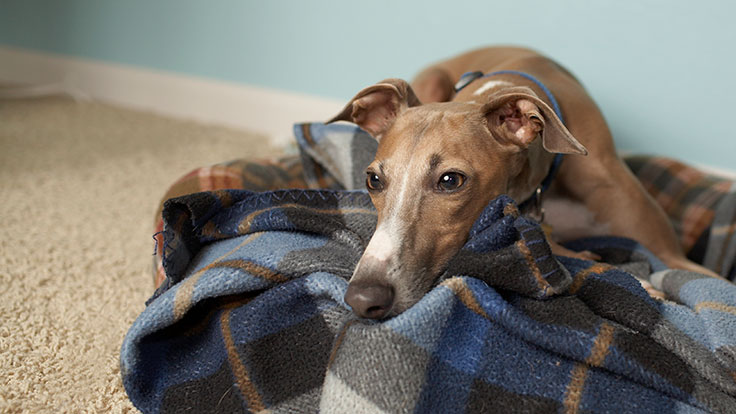
These dogs are true gentle giants. Although they were originally bred as hunting dogs, greyhounds are known for their sweet, loving nature, and will tolerate as much love and affection as you can possibly give them. As such, they don’t like being alone, so they’re best suited for someone who’s ready to give them lots of company.
Greyhounds are often used as racing dogs, so it won’t surprise you to know that they’re incredibly fast and love a good race. But don’t let that put you off – these dogs like sprints, not marathons. After a daily walk or run around the park, they’ll be ready to curl up and sleep for hours, which makes them a great choice for over 50s. If you’re looking for a friend to chill out with you on the sofa, a greyhound might be the perfect choice for you.
One thing to note about these dogs is their fur. Despite their short coats, these dogs shed a lot, so will need to be brushed daily. They’re also a bit more cautious than other dog breeds, so need patience when being introduced to children, strangers and other dogs. Once they’ve got used to visitors, though, they’ll love all the extra attention.
Breed type: Hound
Coat and colour: Short, smooth coat (any colour)
Size: 2 feet 1 inch to 2 feet 6 inches tall at the shoulder (weight: 50-85 pounds)
Life expectancy: 12-15 years
5. Golden retriever
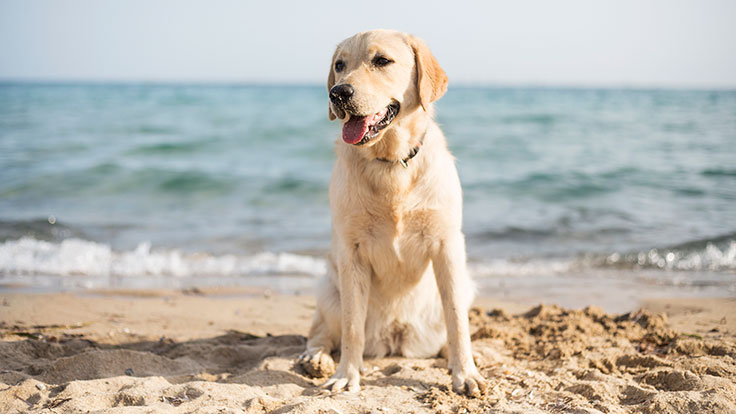
Golden retrievers are one of the most popular dog breeds around, and it’s easy to see why. These super happy dogs always seem to have a smile on their face, and they’ll get on with just about anyone, whether that’s strangers, kids or other dogs. They’re also extremely tolerant, which is perfect if you’re going to have toddlers visiting!
Golden retrievers are super intelligent and incredibly easy to train, but they need plenty of mental and physical stimulation to keep them out of mischief. They’ll need at least 40 to 60 minutes of vigorous exercise a day, so they’re better suited to a fairly active lifestyle. If there’s one nearby, they love showing off their skills in agility classes or activities.
Although they’re usually very gentle, these dogs are also fairly large and really strong, so they might not be suited to people with reduced mobility. To keep the tangles out of their gorgeous coat, golden retrievers need to be brushed daily, and will need a bath about once a month.
Breed type: Sporting
Coat and colour: Medium double coat (varying shades of gold)
Size: 21-24 inches tall at the shoulder (weight: 55-57 pounds)
Life expectancy: 10-12 years
6. Pembroke Welsh corgi
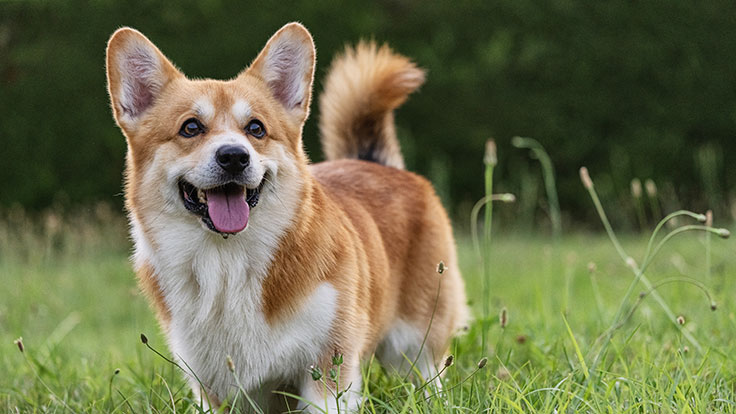
Famous for their little legs and big, beautiful ears, corgis make one cute companion. Originally bred to herd cattle, these are really intelligent pooches, so they’re fairly easy to train. They’re also super loving and get on great with kids and other dogs. When it comes to strangers, though, they can be a bit protective and might give them a loud bark. But once they get used to any newcomers, they’ll be happy to cuddle up to them.
Despite their short legs, corgis actually have loads of energy. They’ll need plenty of walks and lots of playtime, so they’re better suited to fairly active lifestyles. In terms of grooming, their fluffy coat is actually really easy to maintain, and they won’t need many baths, but they will need daily brushing to keep their coat under control.
Breed type: Herding
Coat and colour: Short double coat (can come in a variety of colours, including red, black, tri-coloured and fawn, usually with white markings)
Size: 10-12 inches tall at the shoulder (weight: up to 30 pounds)
Life expectancy: 12-14 years
7. Beagle
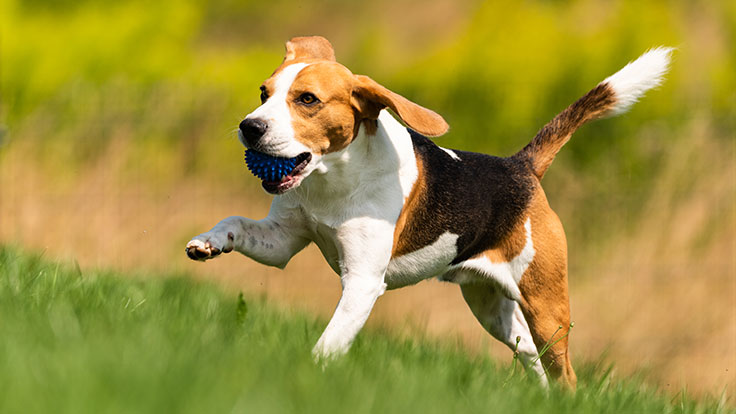
Beagles are certainly ones for a more active lifestyle! If you want a dog to join you on long walks and hikes, a beagle is a great choice. They’re also incredibly sweet and loving, and will get along great with children, strangers and other dogs. In fact, because they’re pack animals, they often prefer the company of other dogs.
But it’s also important to note that these dogs can be boisterous and a little bit mouthy, so they’ll need supervision and lots of training when around young children. Beagles also need a little extra work to get them fully trained. Although their nature is a gentle one, they love to outsmart you and will think nothing of misbehaving – especially if they’re following a scent.
They also love digging, so bear this in mind if you’re currently cultivating a very nice garden. On the plus side, beagles aren’t too difficult to groom. They’ll need brushing about once a week, but they don’t need many baths.
Breed type: Hound
Coat and colour: Short, smooth coat (usually tri-coloured with a tan head, black saddle area and white chest, legs and belly)
Size: 13-15 inches tall at the shoulder (weight: 18-30 pounds)
Life expectancy: 10-15 years
8. Maltese
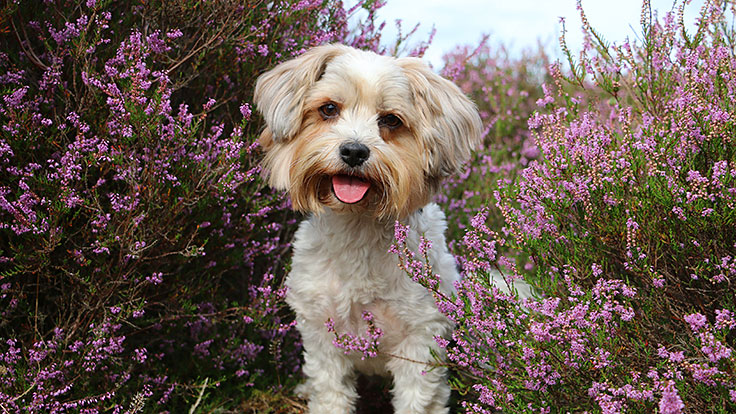
These glamorous little pooches are known for more than just their coat. Intelligent, loving and super friendly, they make the perfect companion for retirees. Although they love a nice walk and plenty of playtime, they don’t need much exercise, so they’re great for people with a less active lifestyle. They’re also incredibly loyal, which means they can be a bit overprotective of their favourite humans.
In general, Maltese are fairly easy to train, with the exception of housetraining, which can take a little more time. To help them along, you might need to spend some time crate training. And it probably won’t surprise you that that long, white coat needs lots of attention. Even if your pooch has a short trim, they’ll need to be brushed every day, and should get a bath once a week.
If you’re looking for a pocket-sized, gentle dog to keep you company (and you don’t mind a bit of extra grooming), Maltese are a great choice.
Breed type: Companion
Coat and colour: Long silky coat (white)
Size: 8-10 inches tall at the shoulder (weight: up to 7 pounds)
Life expectancy: 12-15 years
9. Cavalier King Charles spaniel
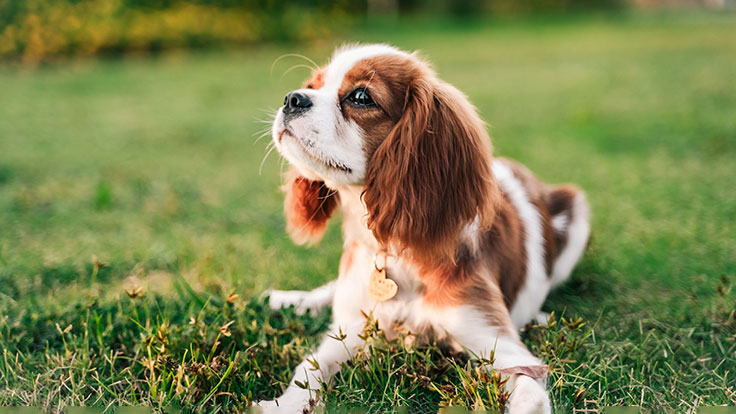
Loving, gentle and silky soft, Cavalier King Charles spaniels make a wonderful friend and housemate. Their peaceful disposition makes them a hit with strangers, children and dogs alike, which is why some of them have found employment as therapy dogs. But their love of people does mean they don’t like to be left alone for long periods of time. This is a pooch that will want to stick by your side at all times!
One of the good things about these spaniels is that they’re incredibly adaptable. If you’ve got an active lifestyle, they’ll love to join you for long walks. But if you’re more of a relaxed type, this dog will settle into its life on the sofa just as happily. That said, they do still need some moderate exercise to keep them happy and healthy.
Training your King Charles should be fairly easy: they love food, and positive reinforcement will help them nail those key behaviours. Despite their luscious locks, these pooches don’t actually need much grooming – just a brush several times a week, and a bath every month.
Breed type: Companion
Coat and colour: Medium silky, wavy coat (can come in four different colour: Blenheim, tricolour, ruby, and black and tan)
Size: 12-13 inches tall at the shoulder (weight: 13-18 pounds)
Life expectancy: 9-15 years
10. Mongrels
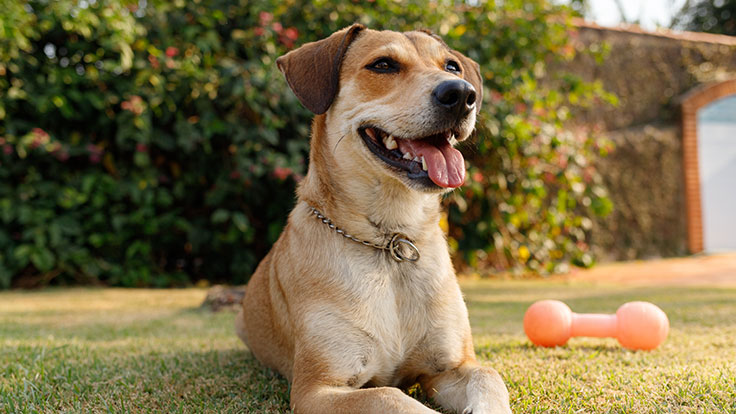
All dogs are deserving of love and companionship, and none are more deserving than the mongrel. Most of the dogs we’ve mentioned above are pedigree, which can mean your new companion could be rather expensive and have potential health issues. A mongrel or mutt is a mix of many breeds, meaning they can be healthier and live longer.
Many people choose pedigree because you know what you’ll get in terms of character traits. However, shelters that house a mix of unique mongrels tend to be able to match a dog’s personality to a new owner better than breeders can. They only may have an inkling of which breeds are within the mongrel family tree, but this gives them an individuality that you can’t find elsewhere.
Mongrels are unique and full of character, although sometimes unpredictable in how large they’ll grow. They’re in need of a seriously loving home, and an over 50s home is often perfect for this.
As you’re looking at the other dog breeds for over 50s in this article, it’s important to remember you don’t have to choose purebred – you can look in your local shelter for a dog that is a mix of your chosen breed and others. This way your dog will be healthier, but will have a similar temperament, and you’ll be giving a dog a home that truly needs it.
Breed type: No definable breed
Coat and colour: Mixed (usually multi-coloured or tan)
Size: Mixed depending on breed
Life expectancy: 12-15 years+
Continue reading
When it’s time to retire, dogs can be a wonderful companion for the next stage in your life – and what an exciting stage it can be! For more inspiration about how to make your life after 50 your best years yet, check out some of our other guides:
The thoughts and opinions expressed in the page are those of the authors, intended to be informative, and do not necessarily reflect the official policy or position of SunLife. See our Terms of Use for more info.
